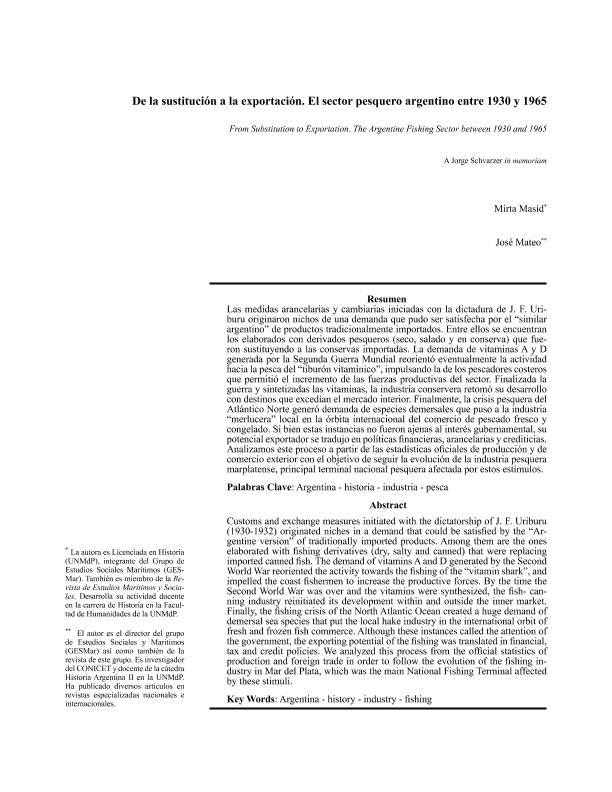Artículo
Las medidas arancelarias y cambiarias iniciadas con la dictadura de J. F. Uriburu originaron nichos de una demanda que pudo ser satisfecha por el “similar argentino” de productos tradicionalmente importados. Entre ellos se encuentran los elaborados con derivados pesqueros (seco, salado y en conserva) que fueron sustituyendo a las conservas importadas. La demanda de vitaminas A y D generada por la Segunda Guerra Mundial reorientó eventualmente la actividad hacia la pesca del “tiburón vitamínico”, impulsando la de los pescadores costeros que permitió el incremento de las fuerzas productivas del sector. Finalizada la guerra y sintetizadas las vitaminas, la industria conservera retomó su desarrollo con destinos que excedían el mercado interior. Finalmente, la crisis pesquera del Atlántico Norte generó demanda de especies demersales que puso a la industria “merlucera” local en la órbita internacional del comercio de pescado fresco y congelado. Si bien estas instancias no fueron ajenas al interés gubernamental, su potencial exportador se tradujo en políticas financieras, arancelarias y crediticias. Analizamos este proceso a partir de las estadísticas oficiales de producción y de comercio exterior con el objetivo de seguir la evolución de la industria pesquera marplatense, principal terminal nacional pesquera afectada por estos estímulos. Customs and exchange measures initiated with the dictatorship of J. F. Uriburu (1930-1932) originated niches in a demand that could be satisfied by the “Ar- gentine version” of traditionally imported products. Among them are the ones elaborated with fishing derivatives (dry, salty and canned) that were replacing imported canned fish. The demand of vitamins A and D generated by the Second World War reoriented the activity towards the fishing of the “vitamin shark”, and impelled the coast fishermen to increase the productive forces. By the time the Second World War was over and the vitamins were synthesized, the fish- canning industry reinitiated its development within and outside the inner market. Finally, the fishing crisis of the North Atlantic Ocean created a huge demand of demersal sea species that put the local hake industry in the international orbit of fresh and frozen fish commerce. Although these instances called the attention of the government, the exporting potential of the fishing was translated in financial, tax and credit policies. We analyzed this process from the official statistics of production and foreign trade in order to follow the evolution of the fishing in- dustry in Mar del Plata, which was the main National Fishing Terminal affected by these stimuli.
De la sustitución a la exportación. El sector pesquero argentino entre 1930 y 1965
Título:
From Substitution to Exportation. The Argentine Fishing Sector between 1930 and 1965
Fecha de publicación:
11/2008
Editorial:
GESMar
Revista:
Revista de Estudios Marítimos y Sociales
ISSN:
1852-0669
Idioma:
Español
Tipo de recurso:
Artículo publicado
Clasificación temática:
Resumen
Palabras clave:
Historia
,
Pesca
,
Producción
,
Comercio
Archivos asociados
Licencia
Identificadores
Colecciones
Articulos(MACNBR)
Articulos de MUSEO ARG.DE CS.NAT "BERNARDINO RIVADAVIA"
Articulos de MUSEO ARG.DE CS.NAT "BERNARDINO RIVADAVIA"
Articulos(OCA PQUE. CENTENARIO)
Articulos de OFICINA DE COORDINACION ADMINISTRATIVA PQUE. CENTENARIO
Articulos de OFICINA DE COORDINACION ADMINISTRATIVA PQUE. CENTENARIO
Citación
Masid, Mirta; Mateo, Jose Antonio; De la sustitución a la exportación. El sector pesquero argentino entre 1930 y 1965; GESMar; Revista de Estudios Marítimos y Sociales; 1; 11-2008; 71-81
Compartir




